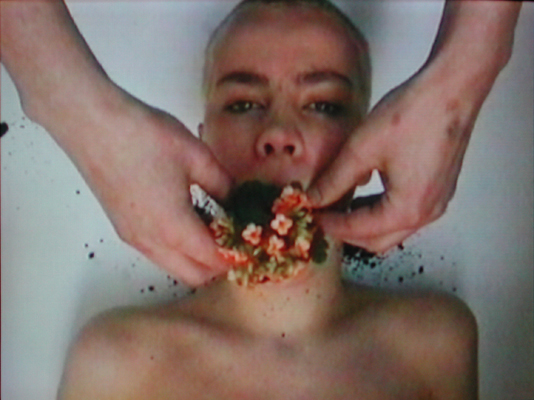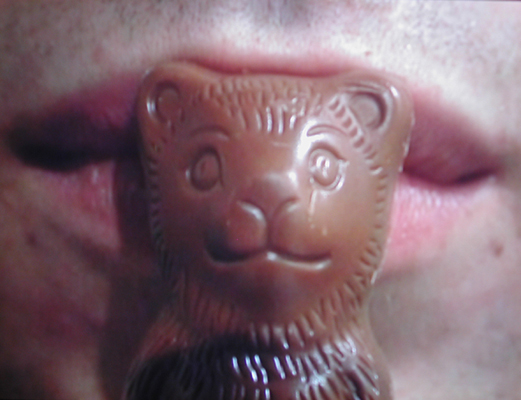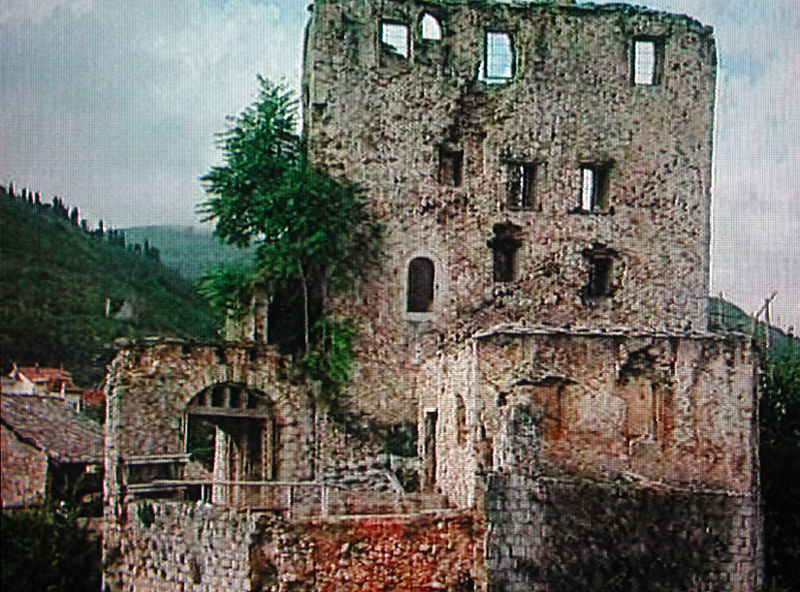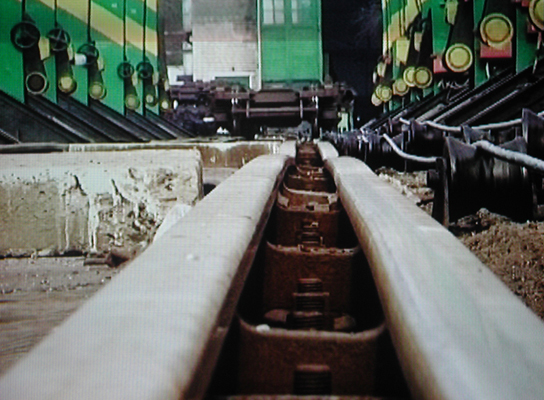New Video, New Europe
New Video, New Europe: A Survey of Eastern European Video, The Renaissance Society, Chicago, 11 January — 22 February 2004(The exhibition will also travel to St. Louis and to the Tate in London.)
It is important to acknowledge the integral role video art has played in disrupting the institutional sanctity of the white cube. The traditional relationship between author, viewer, and subject gives way to spatial experiences that reconstitute the parameters of time and place. Video has also problematized standard curatorial practices presenting a new set of challenges, particularly how to display video works neither as film nor static objects, but as moving images equally open to interpretation.
The exhibition “New Video, New Europe,” spotlighting contemporary video from East Central Europe, locates the medium’s practice both within a particular geographic region and within a broader cultural discourse. In total, fifty-two works by over three dozen artists from some sixteen countries are included, with extra weight given inexplicably to Estonia, Romania, Serbia, and Croatia. The title is a bit of a misnomer. While most videos are recent, some works, for example the eulogistic Black Sun and Namebook by Estonian Tiia Johannson, date as early as 1990/97 and 1996, respectively. Likewise, several videos have appeared elsewhere in large international exhibitions, such as “After the Wall” (1999), “Manifesta 3” (2000), and “Documenta 11” (2002), although here they make their American debut.
A downfall of some of these global surveys has been achieving the right structural balance between the needs and demands of video and those of more traditional art forms. “New Video, New Europe” succeeded in opening the physical and conceptual spaces of the Renaissance Society creating a multi-layered environment that allowed viewers to move fluidly and independently between works. At the gallery’s center were four viewing spaces, each devoted to one of the following themes: The lingering trauma of civil war and violent regime change; Experimental video pre and post digital, pre and post MTV; From isolation to globalization: artisanal labor, national identity, and the GDP; and Ethnography, documentary, diary, and disclosure. Purposefully grand, these groupings were never fixed but open-ended, encompassing many genres and subthemes, with some works falling easily under more than one category. Additionally, seven installational works, presented either on monitors or projected onto screens, were scattered throughout the gallery, together constituting a “fifth” program.The “Technicolor” Lucy (2000) by Estonians Killu Sukmit and Mari Laanemets actually appeared in both the gallery program and the viewing room devoted to experimental video, although it wasn’t clear why it deserved double billing. Here, the title character, eyes shut while dreaming, cascades from the sky. A voice asks, “Where are you going?” “I am going to Heaven,” Lucy replies.
Works in the gallery program did not adhere to a particular theme, but what emerged was a sense of the body as a site for political and religious moralizing, countered by other works centered on spiritual transcendence. Upon entering the gallery, viewers were confronted with the image of two hands planting flowers into the mouth of an androgynous being. This somewhat torturous act is typical of the body-based works of Estonian Ene-Liis Semper (who is, by the way, the figure we see), known for her disturbing psychoanalytic explorations of death.

Ene Liis Semper, ‘Oasis’ (Video Still, 1999).
Some of these same issues are explored in the works of Serbian Vladimir Nikolic and Romanian Patricia Teodorescu. The title Oasis (1999) refers, perhaps, to the marginalized position of the East Central European artist; it also suggests that the body is a barren vessel easily filled by ideology. In Nikolic’s Rhythm (2001), four men and one woman stand expressionless in a mock lineup. Each gestures signs of the cross to a hypnotic techno beat; starting in unison, they fall out of synch, then eventually regain rhythm.

Patricia Teodorescu, ‘Bear’ (Video Still, 2000)
Individuality gives way to uniformity and unwavering belief, as also suggested in Teodorescu’s Bear (Revelation) (2000), where a mouth sensuously licks a chocolate bear — a very literal translation of the belief that equates, we are told in bits of running text, the formation of bear cubs by their mothers’ tongues with the formation of Christians by missionaries. The directness of both these works contrasts with Estonian Ki’Wa’s ethereal Work in Progress (1998), where another androgynous figure (also the artist) spray paints the Japanese symbol for “no” as s/he wanders through a tranquil, color-washed landscape.
The exhibition’s most provoking videos were found in the program dedicated to communism’s overthrow and the effects of the region’s civil wars.

Adrian Paci, ‘MOST’ (Video Still, 2000).
More documentary works, such as Bosnian Alma Becirovic’s Survived “N” Lived Another Day (2001) and Serbian Dragana Zarevac’s Most (2000), are candid psychological portraits of those living in the aftermath of the Bosnian war. In the first, the camera follows a single mother and one of the few female members of the Bosnian de-miners corps as she bravely searches for mines. Most mixes images of destruction with interviews of residents from Mostar, whose famed Ottoman bridge was destroyed in 1993. “The spirit of Mostar is in that bridge,” one man admits. Such statements reveal a sense of loss as well as eternal life. In both videos, the natural beauty of the landscape belies the horror of what has been endured.
Bosnian Maja Bajevic’s Double Bubble (1999) is a study in hypocrisy. With deadpan delivery, the artist recites various atrocities committed in the name of religion — “I go to church; I rape women.” “Whoever doesn’t think like me must die. It is God’s will.” — as she wanders through a series of stark, darkly lit interiors. Each crime is repeated in a voice-over as if a mantra. This act of self-absolution speaks o f those who committed similar crimes during the war in Yugoslavia and from whom there will never be an admission of guilt.

Adrian Paci, ‘Albanian Stories’ (Video Still, 1997).

Adrian Paci, ‘Albanian Stories’ (Video Still, 1997).
Adrian Paci’s bittersweet Albanian Stories (1997), about the war in Kosovo, marks the end of innocence. This seemingly simple recording of his daughter spinning wild tales of cats, cocks, and cows turns disturbingly real when she introduces “the international forces,” whose flames and gunshots force her characters to flee Albania for Italy. Such works contradict the sense of freedom and optimism experienced by many with the fall of the Berlin Wall. Instead, they reflect the demise of the socialist state into a series of nation-states demarcated along ethnic and religious lines, a region plagued by political instability.
Along with European Unification, East Central European identity, both individual and geographic, remains ill defined. Issues of identity, while to some extent a subtext of the entire show, were addressed more directly in the program “From isolation to globalization.” Croatian Kristina Leko’s In Her 25,802nd Day (2000) is a loving homage to Zagreb’s female flower vendors, as well as an oblique commentary on the region’s fading agricultural economies. Using a quasi-interview format, the camera focuses on each woman’s face, whose deep lines or soft contours define her age, also denoted, as suggested by the title, in days.
More revealing, and inventive, were those works that employed subtle humor, such as Estonian Kai Kaljo’s self-effacing A Loser (1997), in which the artist discloses the basic facts of her life — “I am an Estonian artist.” “I am thirty-seven years of age but still living with my mother.” “I make $90 a month teaching at the Academy of Art.” — each admission followed by canned laughter. Kaljo’s caricature is offset by Bulgarian Krassimir Terziev, whose On the BG Track (2002) juxtaposes celluloid stereotypes of Bulgarians, taken from clips of well-known Hollywood movies, with everyday street scenes of the capital Sofia.
In his tongue-in-cheek, fast-action video, Sislej Xhafa, originally from Kosovo, transformed the Ljubljana train station into a commodities exchange. Donned in a business suit, the artist stands by the station’s arrivals and departures sign, shouting destinations and travel times, while mimicking the gestures of a stock trader.
Xhafa’s work was one of the few to address issues of migration and immigration. Also rare were depictions of East Central Europe’s multi-ethnic populations with the exception of the emotionally moving Kanagjeci (2002) by Erzen Shkololli, also from Kosovo, shown in the documentary program. With a respectful and distanced eye, the artist provides an ethnographic look at a Romany wedding ritual, in which a veiled young bride gathers with her female family members and friends to mourn.
Other memorable works from the documentary category give testament to the realities of a transitional Europe, places either resistant to change or still operating within the structural and political apparatus of the communist system. In Lithuanian Arturas Raila’s The Girl Is Innocent (1999), aged ideologues warn against the evils of Americanism during student critiques at the Vilinus Secondary School of Fine Art.

Pavel Braila, ‘Shoes for Europe’ (Video Still, 2002).
Moldovan Pavel Braila’s Shoes for Europe (2002) details the laborious task of readying a train for passage from East to West at the Moldovan-Romanian border. Documented is the painstaking process of changing the Russian wheel gauges still used in Moldavia to those used in Western Europe. Braila’s rich and nuanced camerawork, coupled with a keen sense of geometry, imbues his subject with the formal beauty of a photograph.
Some of the exhibition’s least rewarding works were found in the experimental program, although here East Central Europe’s transnational identity was explored as a byproduct of other themes. The more unique expressions found elsewhere were not as frequent in this collection, which suffered from an overuse of found and pop imagery, synthesized soundtracks, and quick-fire editing, but this was probably a curatorial issue rather than an artistic one. (I must admit, however, that Ki’Wa’s send up to Estonian pop star Anne Veshi, with most of the same trappings, was a lot of fun.)
The real stand out was Hungarian Varnai Gyula’s sci-fi still life Magic (2003), in which a human hand emerges from a blackened void then morphs into a series of unrelated objects (a chair, a bowl, a knife). Known for his conceptual installations that redefine notions of objecthood, Varnai impressively translates his interest in the physicality of things to the realm of the corporeal, exploiting the potentials of his chosen medium.
One learns in “New Video, New Europe” that the video artist in East Central Europe is both a provocateur and a scribe, a witness to history whose own interventions speak of moral responsibility and redefinitions of self. Given the fragmentary nature of the present, video seems an apt tool for deconstructing narratives of the past, as well as a democratic vehicle for envisioning the future.





